Physical Address
304 North Cardinal St.
Dorchester Center, MA 02124
In this chapter, space-occupying lesions including brain tumors, vein of Galen malformations, and arachnoid cysts are discussed. These disorders are considered in the same chapter because they represent important intracranial mass lesions and share certain clinical features. We do not review in detail management, which is considered in depth in standard neurosurgical writings. Improvements in management in recent years have made the prognosis of these serious disorders considerably more favorable than in the past. But although the prognosis has improved, very few children with neonatal mass lesions will survive without unfavorable consequences, which can include hydrocephalus, intractable seizures, or significant developmental delay. Because the risk of interventions, such as anesthesia and blood loss, are tolerated better by infants older than 3 months, definitive treatment may be deferred until later in infancy. Arachnoid cysts are an exception, because they are often treated now with minimally invasive techniques.
Brain tumors manifesting either at birth (or in utero) or within the first 2 months of life account for approximately 1% to 2% of all brain tumors encountered in the pediatric age group, or 1 to 3 cases per 1 million live births. Although in most major reviews neonatal brain tumors are grouped with tumors manifesting in the first 1 to 2 years of life, brain tumors appearing at birth (or in utero) or in the first two postnatal months are sufficiently distinct in histological and clinical characteristics to be considered separately. In this chapter, we discuss only tumors manifesting at birth (or in utero) and in the first two postnatal months.
The diagnosis, treatment, and prognosis of neonatal brain tumors has progressed markedly since Raskind and Beigel attributed congenital brain tumors to “cell rests” in 1964. Genetic and molecular subtyping of pediatric brain tumors has begun to transform the field. Derangements in the control of cell proliferation and differentiation are central to etiology, and abnormalities of genes encoding proteins that function as growth factors (e.g., platelet-derived growth factor), as stimulators of cell proliferation (e.g., oncogenes), or as suppressors of cell proliferation (e.g., tumor suppressor genes) have been identified in various tumors. Additionally, abnormal genetic material inserted into the human genome by certain viruses may induce tumor formation; polymerase chain reaction technology has been used to show the presence of DNA sequences of simian virus 40, one member of a family of viruses (polyomaviruses) that induces tumors in laboratory animals. These sequences were observed in 10 of 20 choroid plexus tumors and in 10 of 11 ependymomas in children; both these tumors are relatively common in the neonatal period (see later discussion). Molecular classification of ependymal tumors and atypical teratoid rhabdoid tumors (ATRT) was recently proposed. For example, a tumor suppressor protein that regulates chromatin remodeling is missing in some ATRT. Additional mutations in the chromatin remodeling complex gene SMARCB1/HSNF5/INI1 ( SWI/SNF -related matrix-associated actin-dependent regulator of chromatin subfamily B member 1 gene, also known as INI1 ) are present in 23% to 35% of infants with ATRT. Similarly, tumor suppressor p53 mutations have been found in 50% of choroid plexus tumors. Although in many cases progress is still limited to case reports, drugs targeting specific mutations can be effective in situations in which traditional chemotherapy has failed. The pace of genetic discoveries is accelerating with technical advances, and it is anticipated that the field will change markedly over the next decade.
In 2021 the World Health Organization introduced a major reclassification of tumors of the central nervous system (WHO CNS5) with a hybrid nomenclature combining conventional histological criteria with molecular biomarkers. The new taxonomy has introduced 22 unique tumor types that include molecular alterations that may offer potential targets for treatment.
The histological types of neonatal brain tumors differ considerably according to the time of clinical presentation ( Table 41.1 ). Thus teratomas are the predominant tumors in infants who present clinically in fetal life or at birth, whereas tumors of neuroepithelial origin predominate in the first two postnatal months. The high proportion of teratomas shown in Table 41.1 is based on two large series (cumulative total, 425). These lesions are usually very large ( Fig. 41.1 ). Indeed, approximately 35% to 60% are so large that the site of origin in the supratentorial compartment cannot be determined. Nearly 20% of neonatal teratomas originate from the region of the lateral ventricle, and another approximately 10% to 20% originate from the region of the third ventricle. Only uncommonly do neonatal teratomas originate from the pineal region, the site of most intracranial teratomas that manifest clinically after the neonatal period.
| PERCENTAGE OF TUMORS WITH PRESENTATION AT BIRTH OR IN UTERO | PERCENTAGE OF TUMORS WITH PRESENTATION IN FIRST 2 MONTHS | |
|---|---|---|
| Teratoma | 47 | 26 |
| Neuroepithelial | 40 | 65 |
| Other | 13 | 9 |
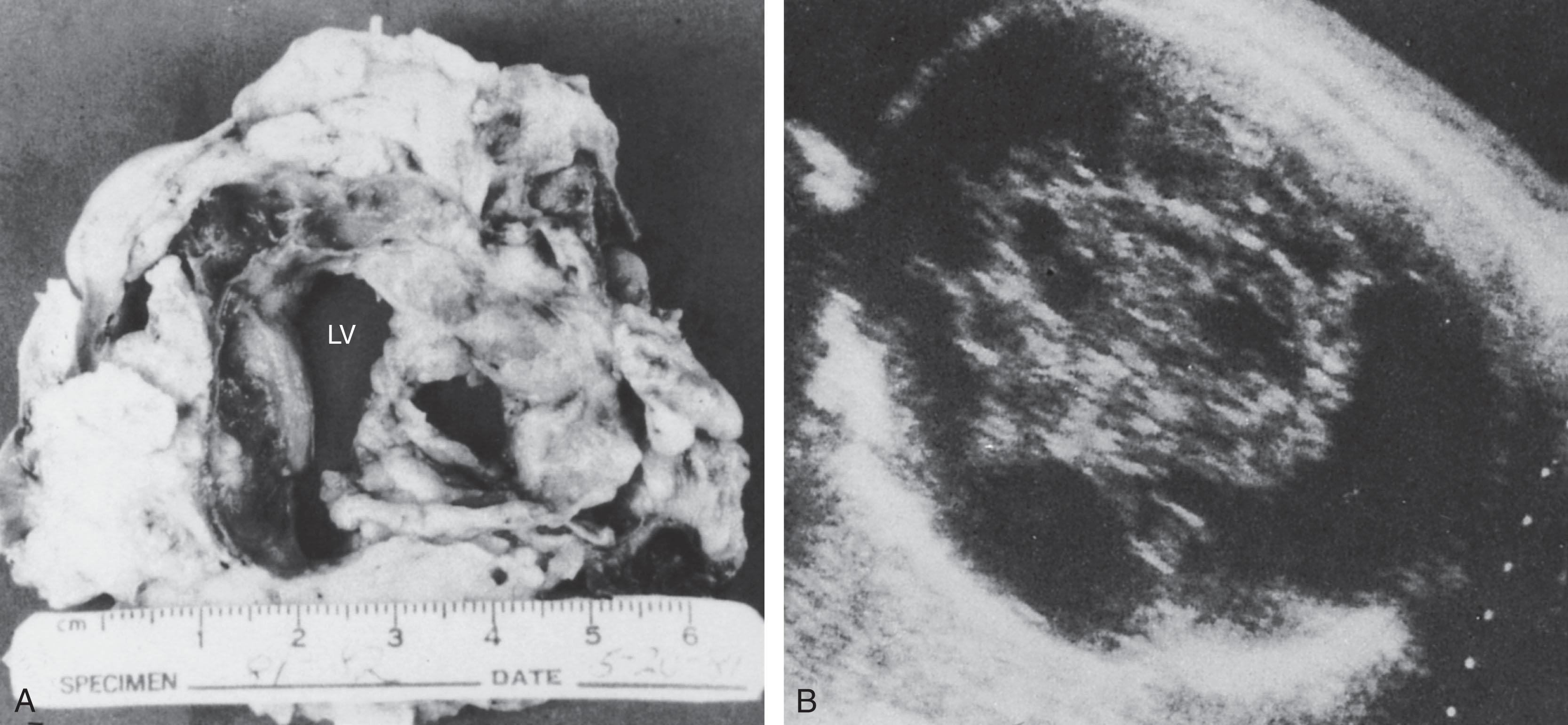
The major types of nonteratomatous tumors (i.e., neuroepithelial and mesenchymal tumors) are shown in Table 41.2 . Astrocytoma is the most common single category and includes low- and high-grade tumors. Diffuse low-grade gliomas are different from those of adults and rarely transform into higher-grade neoplasms. They often contain alterations of the mitogen-activated protein kinase pathway, including a point mutation of the BRAF V600E oncogene, located at position 7q34, which can be targeted with inhibitors. Pilocytic astrocytomas (WHO Grade 1) are the most common astrocytomas of childhood and generally have a very good prognosis. The majority of pilocytic astrocytomas have a truncated tandem fusion on gene 7q34 ( KIAA1549-BRAF ), which also is targetable.
|
|
| Astrocytoma (WHO grade I–IV) | 27% |
| Atypical teratoid/rhabdoid tumor | 18% |
| Choroid plexus papilloma/carcinoma | 16% |
| Ependymoma (WHO grade I–III) | 13% |
| Desmoplastic infantile ganglioglioma | 9% |
| Medulloblastoma/PNET | 8% |
| Glioneuronal tumor | 4% |
| Poorly differentiated carcinoma | 4% |
| Craniopharyngioma | 1% |
a Adapted from Kralik SF,Taha A, Kamer AP, et al. Diffusion imaging for tumor grading of supratentorial brain tumors in the first year of life. AJNR Am J Neuroradiol . 2014;35:815–823. https://doi.org/10.3174/ajnr.A3757 , McGovern SL, Grosshans D, Mahajan A. Embryonal brain tumors. Cancer J . 2014;20:397–402. https://doi.org/10.1097/PPO.0000000000000081 , Qaddoumi I, Carey SS, Conklin H, et al. Characterization, treatment, and outcome of intracranial neoplasms in the first 120 days of life. J Child Neurol . 2011;26:988–994. https://doi.org/10.1177/0883073811401398 , Pillai S, Metrie M, Dunham C, et al. Intracranial tumors in infants: long-term functional outcome, survival, and its predictors. Childs Nerv Syst . 2012;28:547–555. https://doi.org/10.1007/s00381-012-1707-y and Severino M, Schwartz ES, Thurnher MM, et al. Congenital tumors of the central nervous system. Neuroradiology . 2010;52:531–548. https://doi.org/10.1007/s00234-010-0699-0 .
b From Qaddoumi I, Carey SS, Conklin H, et al. Characterization, treatment, and outcome of intracranial neoplasms in the first 120 days of life. J Child Neurol . 2011;26:988–994. https://doi.org/10.1177/0883073811401398 and Pillai S, Metrie M, Dunham C, et al. Intracranial tumors in infants: long-term functional outcome, survival, and its predictors. Childs Nerv Syst . 2012;28:547–555. https://doi.org/10.1007/s00381-012-1707-y .
c Kralik SF,Taha A, Kamer AP, et al. Diffusion imaging for tumor grading of supratentorial brain tumors in the first year of life. AJNR Am J Neuroradiol . 2014;35:815–823. https://doi.org/10.3174/ajnr.A3757 , Qaddoumi I, Carey SS, Conklin H, et al. Characterization, treatment, and outcome of intracranial neoplasms in the first 120 days of life. J Child Neurol . 2011;26:988–994. https://doi.org/10.1177/0883073811401398 , and Pillai S, Metrie M, Dunham C, et al. Intracranial tumors in infants: long-term functional outcome, survival, and its predictors. Childs Nerv Syst . 2012;28:547–555. https://doi.org/10.1007/s00381-012-1707-y .
Pediatric high-grade gliomas have also been reclassified on the basis of molecular alterations, and the term glioblastoma multiforme , the most common malignant high-grade glioma in adults, has been removed from the lexicon of pediatric neoplasms. A unique high-grade glioma of newborns and infants is the infant-type hemispheric glioma , which often harbors receptor tyrosine kinase gene fusions, which are targetable ( Fig. 41.2 ). Preliminary work suggests an improved prognosis for infant-type hemispheric gliomas that are kinase-fusion positive.
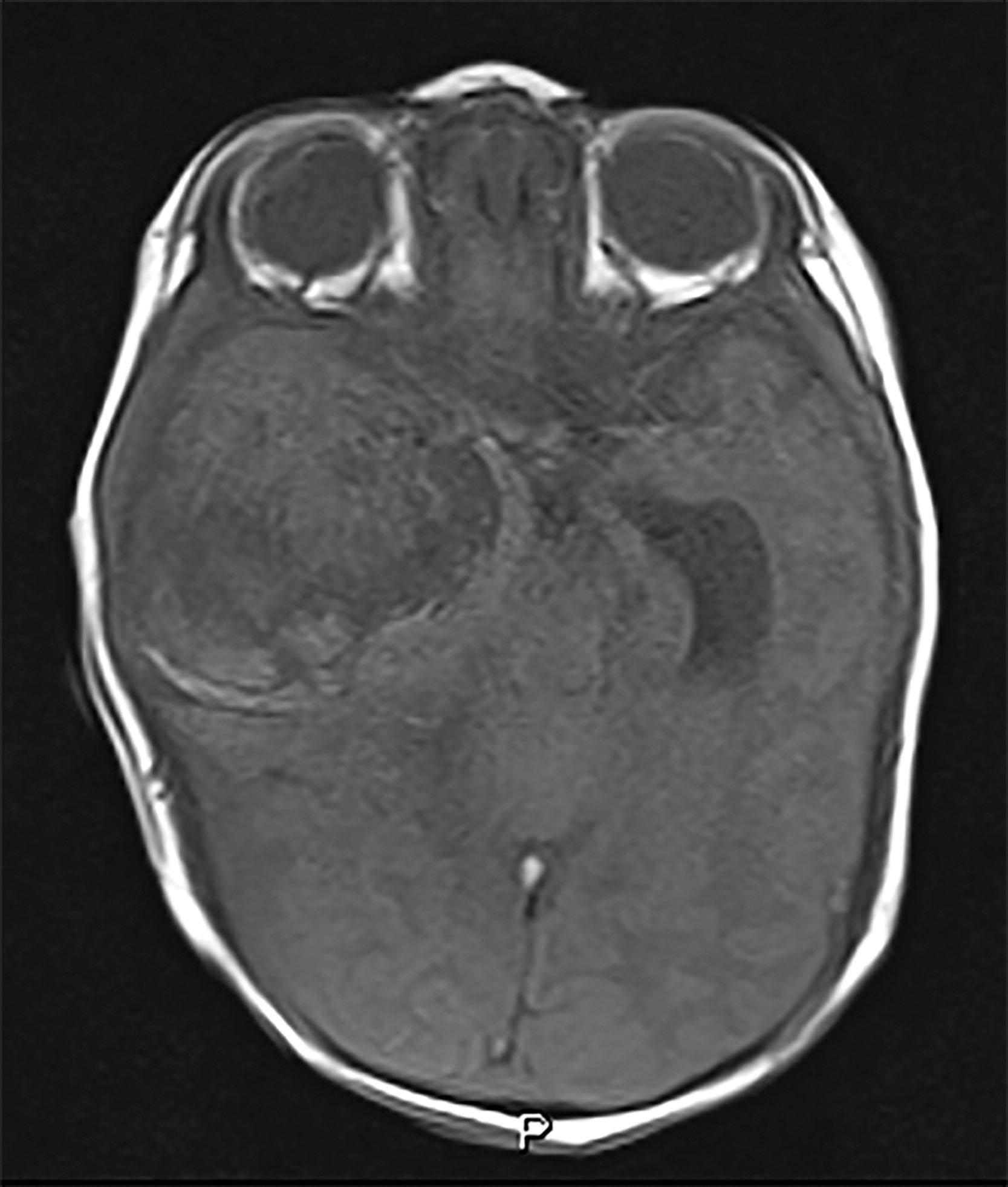
Another malignant neoplasm of childhood, the primitive neuroectodermal tumor has been replaced by the term CNS embryonal tumor , based on unique molecular profiling. The most common CNS embryonal tumor is the medulloblastoma , occurring in the posterior fossa and now categorized in a hybrid fashion based on histology and molecular profiling. Molecular profiling recognizes four distinct subsets of medulloblastoma: wingless integrated (WNT)-activated, sonic hedgehog (SHH)-activated (either TP53 wildtype or TP53 mutated) and non-WNT, non-SHH tumors, each associated with a different prognosis. The medulloblastoma subtypes affecting infants are SHH and non-WNT, non-SHH.
Other embryonal tumors of newborns and infants include the atypical teratoid rhabdoid tumor (AT/RT) and the embryonal tumor with multilayered rosettes (ETMR) . Both tumors are lethal and targeted therapy is being explored. Before molecular profiling, some AT/RTs were misclassified as infant medulloblastomas.
Ependymomas are the third most common brain tumors of childhood, after gliomas and embryonal tumors. Other tumors encountered in newborns include the hypervascular choroid plexus papilloma and carcinoma. The remaining tumors include other primitive neuroectodermal tumors (not medulloblastoma) and desmoplastic infantile ganglioglioma (DIG). DIG accounts for approximately 16% of infantile tumors and must be distinguished from diffuse midline glioma because of the marked difference in prognosis ( Fig. 41.3 ). Both occur supratentorially, have cystic and solid components, and similar features on magnetic resonance imaging (MRI). The prognosis for DIG is generally favorable, although a few more aggressive cases have been reported. Of the neuroepithelial tumors, choroid plexus papilloma has the most consistent site of origin (i.e., the lateral ventricle in most cases). Among other tumors, craniopharyngioma is the most common single type, although sarcoma, fibroma, hemangioblastoma, hemangioma, and meningioma have been documented.
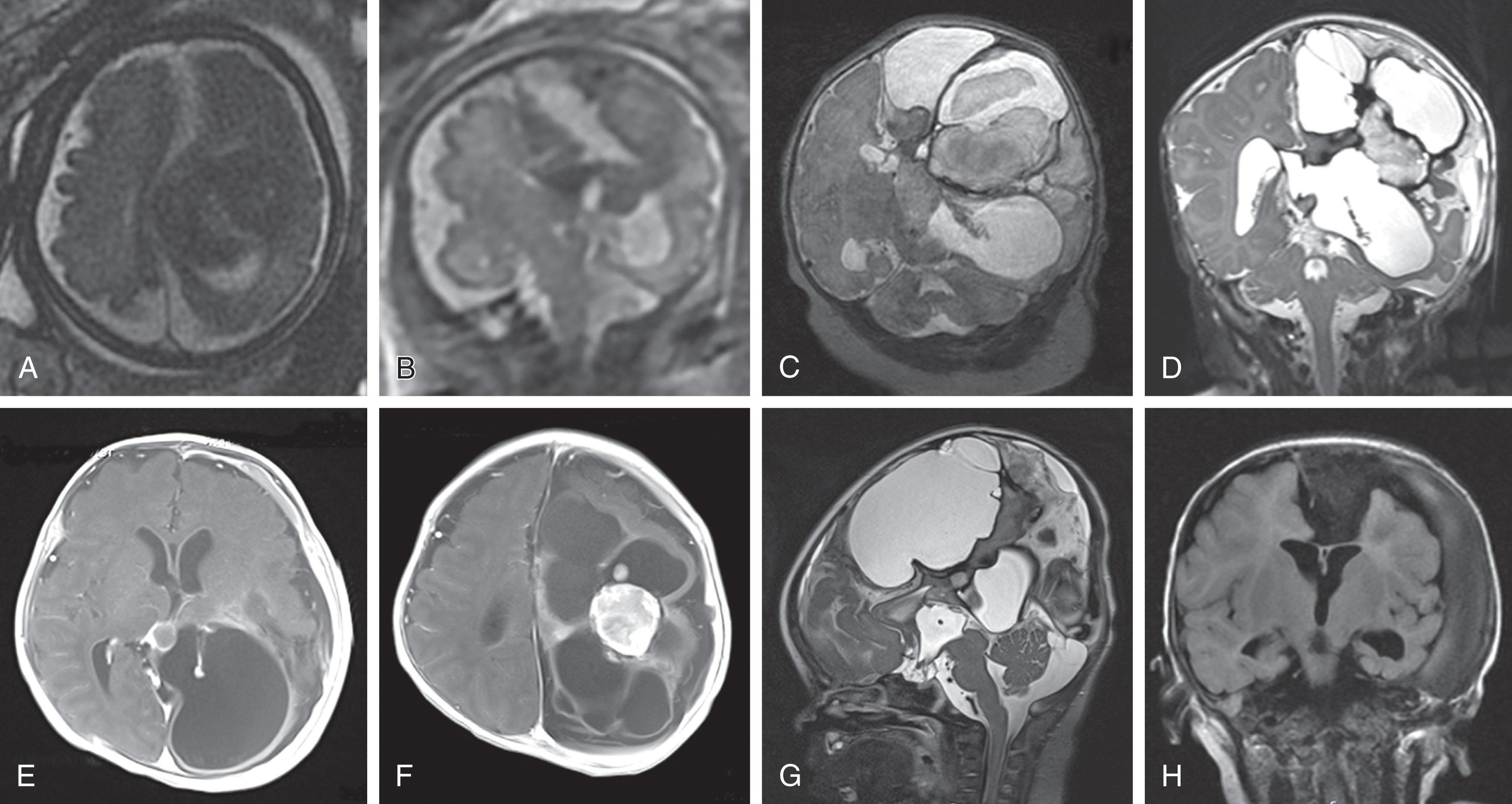
Particularly unusual, additional examples of neonatal brain tumors include intracranial chordoma, derived from midline remnants of notochord, mixed neural tissue masses extending into the oropharynx, hypothalamic hamartoma, lipoma of corpus callosum, multiple lipomata, and subependymal giant cell astrocytoma (SEGA) associated with tuberous sclerosis. SEGAs are driven by dysregulation of the serine/threonine kinase mammalian target of rapamycin (mTOR) pathway. Symptomatic SEGAs can be resected or targeted with mTOR inhibitors, including the macrocyclic lactones everolimus and sirolimus (rapamycin). The SEGAs associated with tuberous sclerosis are usually accompanied in the newborn by cardiac rhabdomyoma, and, indeed, the latter may be the principal clue to the diagnosis of tuberous sclerosis in the neonatal period in such patients (see Chapter 5 ). The cardiac tumor may lead to cardiac complications (e.g., arrhythmia) that can be life-threatening at the time of surgery for the subependymal astrocytoma. The mTOR inhibitor everolimus has shown benefit in a few infants with tuberous sclerosis complex tumors.
The location of neonatal brain tumors is distinctly different from that observed in pediatric patients in late infancy and childhood ( Table 41.3 ). Thus supratentorial predominance is apparent, with 60% to 70% supratentorial. This predominance is marked for teratomas, which are nearly always supratentorial in location. In contrast, medulloblastoma is the one type of neonatal brain tumor with consistent predominance in the infratentorial compartment. If only neuroepithelial tumors are considered, the ratio of supratentorial to infratentorial lesions is 1.7:1 for tumors manifesting at birth and 2.4:1 for those appearing in the first two postnatal months. If all neonatal brain tumors are considered (i.e., teratomas and mesenchymal tumors, as well as neuroepithelial tumors), the supratentorial predominance is even more marked (see Table 41.3 ).
| PRESENTATION AT BIRTH | PRESENTATION IN FIRST 2 MONTHS | |||
|---|---|---|---|---|
| SUPRATENTORIAL | INFRATENTORIAL | SUPRATENTORIAL | INFRATENTORIAL | |
| Teratoma | 44 | 0 | 18 | 1 |
| Neuroepithelial | ||||
| Medulloblastoma | 2 | 7 | 1 | 8 |
| Astrocytoma | 5 | 3 | 9 | 2 |
| Choroid plexus papilloma | 6 | 0 | 9 | 0 |
| Ependymoma, ependymoblastoma | 4 | 0 | 7 | 2 |
| Other neuroepithelial | 10 | 6 | 8 | 2 |
| Total of all neuroepithelial tumors | 27 | 16 | 34 | 14 |
| Supratentorial-to-infratentorial ratio for neuroepithelial tumors | 1.7:1 | 2.4:1 | ||
| Supratentorial-to-infratentorial ratio for all tumors (teratoma, neuroepithelial, mesenchymal) | 5.2:1 | 3.4:1 | ||
The clinical features of neonatal brain tumors can be divided essentially into four major syndromes ( Table 41.4 ). The first syndrome is characterized by a mass lesion that is so large in fetal life that severe macrocrania results in cranial-pelvic disproportion, dystocia, stillbirth, or premature labor. This “obstetrical” syndrome is characteristic of teratomas ( Fig. 41.4 ), but it may also be observed with large neuroepithelial tumors (see Table 41.4 ). Commonly, other features related to displacement of intracranial tissue by tumor (e.g., local skull swelling, proptosis, or epignathus) may be present in this syndrome.
| SIGNS AND SYMPTOMS | PRESENTATION AT BIRTH | PRESENTATION IN FIRST 2 MONTHS | |
|---|---|---|---|
| TERATOMA | OTHERS | ||
| Dystocia | 45% | 20% | – |
| Stillborn | 40% | 15% | – |
| Prematurity | 30% | 20% | – |
| Large head and/or bulging fontanelle | 70% | 55% | 70% |
| Epignathus | 10% | – | – |
| Local skull swelling | 10% | 5% | 2% |
| Proptosis | 8% | 1% | – |
| Seizure | – | 2% | 15% |
| Vomiting | – | 1% | 30% |
a n = 200 in reference 1, n = 250 in reference 7, and n = 534 in reference 9. Numbers are rounded off.
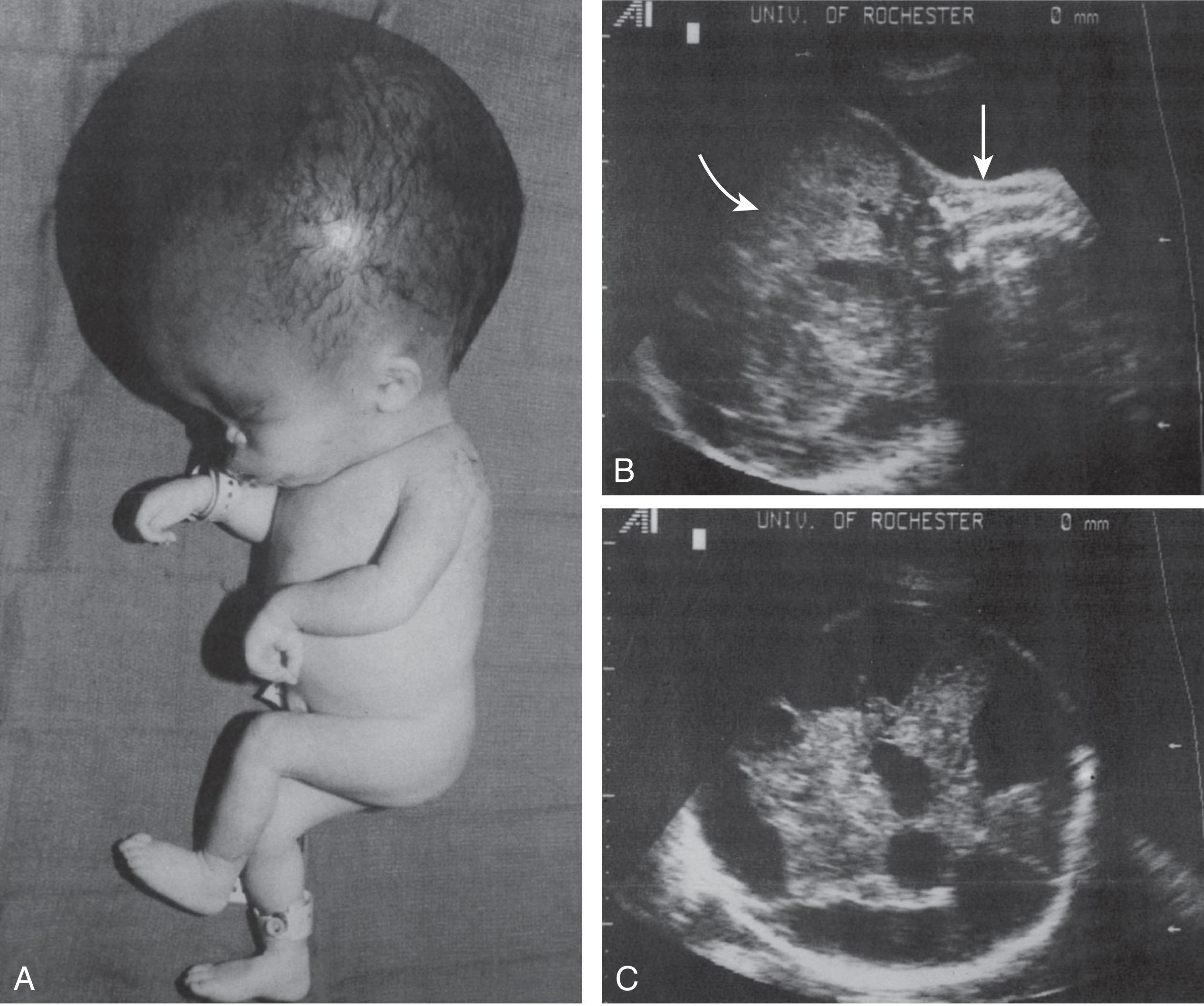
The second syndrome is characterized predominately by macrocrania and bulging fontanelle, often secondary to hydrocephalus, and is observed in approximately 50% of newborns with CNS tumors. Seizures and progressive macrocephaly are observed with DIG tumors. This syndrome also may accompany the features just described for teratomas and may occur for tumors that manifest at birth or in the first two postnatal months (see Table 41.4 ).
The third syndrome consists of specific neurological features related to the particular type and location of the tumor and is particularly characteristic of tumors manifesting after birth, in the first two postnatal months. These neurological features include seizures, present in 15% to 25% of patients with neonatal brain tumors, hemiparesis or quadriparesis, cranial nerve abnormalities, and signs of increased intracranial pressure, often secondary to hydrocephalus. The last of these characteristics is a consistent feature of choroid plexus papilloma. Specific neurological features of spinal cord tumors include torticollis with high cervical spinal cord lesions, usually astrocytoma, and weakness of lower extremities with disturbance of sphincter function in lumbosacral-coccygeal lesions, usually teratoma. The spinal cord lesions are particularly important to identify promptly, because abrupt neurological deterioration may occur spontaneously or after mild trauma (e.g., neck manipulation).
The fourth syndrome associated with neonatal brain tumors is abrupt onset of intracranial hemorrhage ( Figs. 41.5 and 41.6 ). Hemorrhage with brain tumor is more common in neonatal lesions than in tumors at later ages and develops in approximately 8% to 18% of cases, more commonly in patients with neuroepithelial lesions or vascular tumors (e.g., cavernous hemangioma) than in patients with teratomas ( Table 41.5 ). More often, the hemorrhage is an incidental finding at the time of diagnostic brain imaging, surgery, or autopsy, but occasionally it is large enough to be the presenting clinical feature. Indeed, any infant with an intraparenchymal hemorrhage with no readily identifiable cause (see Chapter 26 ) should be evaluated for the presence of a brain tumor.
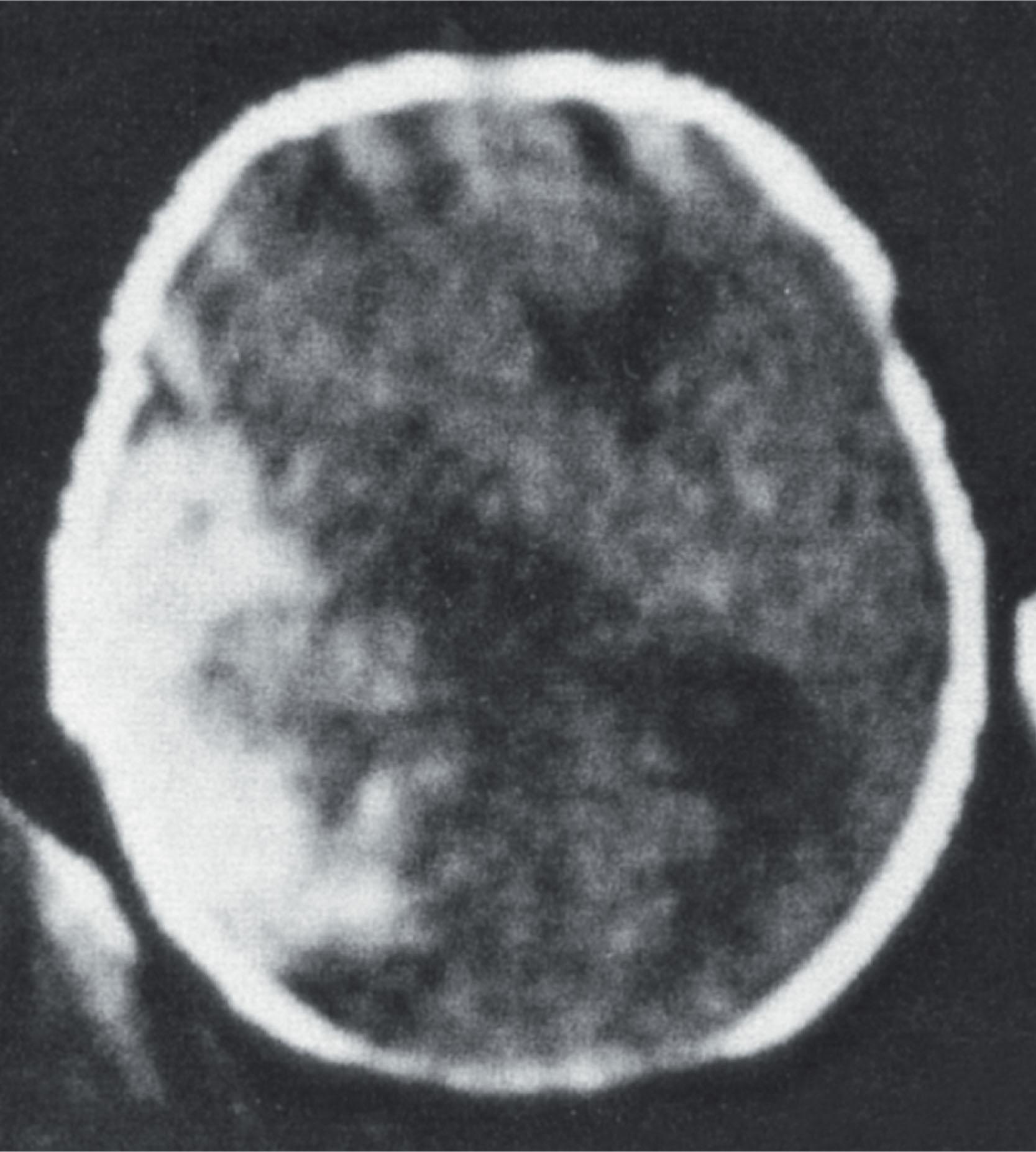
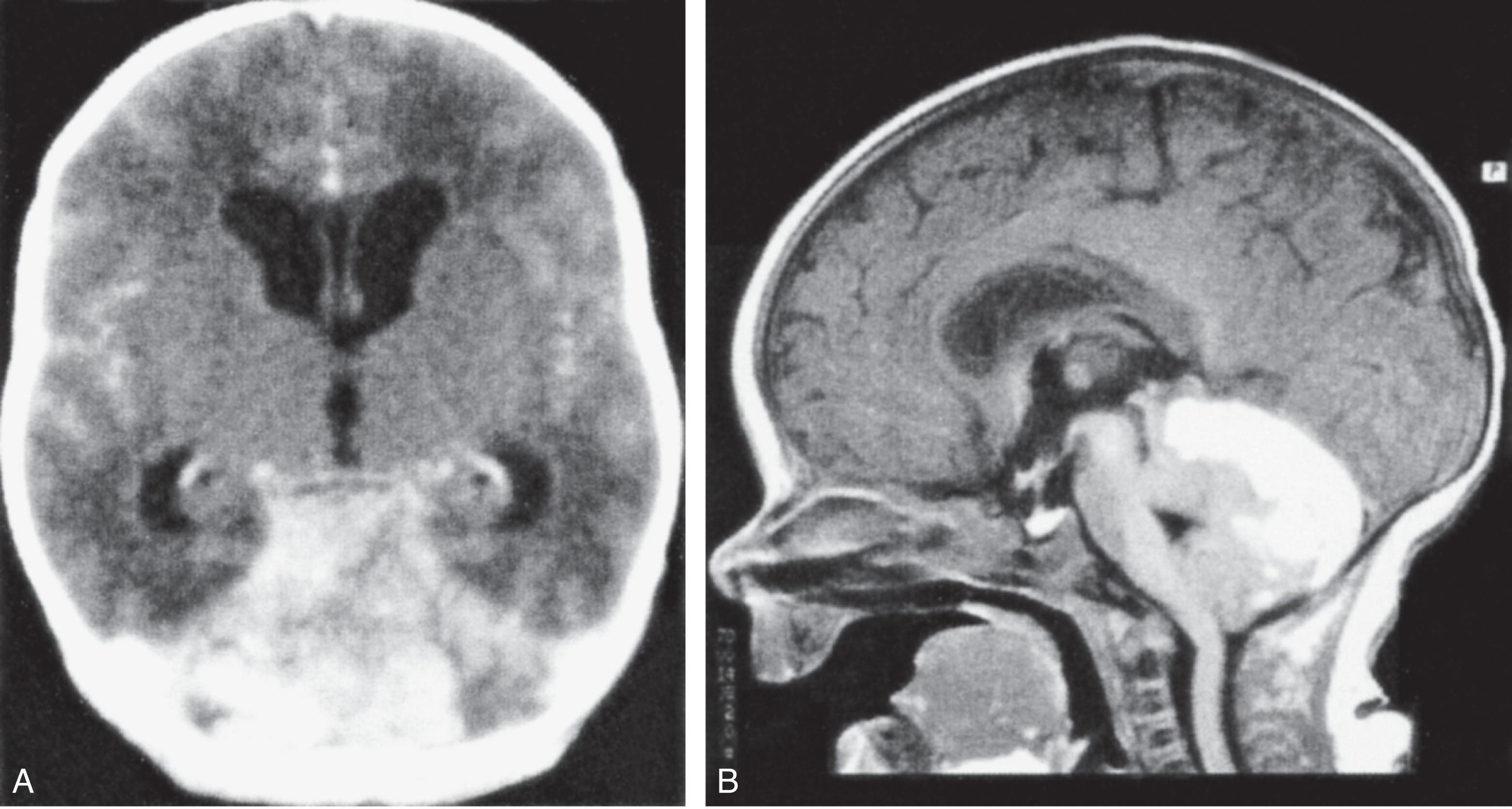
| HISTOLOGICAL TYPE | INCIDENCE OF HEMORRHAGE |
|---|---|
| Teratoma | 8% |
| Neuroepithelial and other | 18% |
| All tumors | 14% |
a Wakai S, Arai T, Nagai M. Congenital brain tumors. Surg Neurol . 1984;21:597–609.
Brain tumors in infants can be difficult to diagnose. The patients are preverbal, and the typical clinician may only see one or two childhood brain tumors in an entire career. The diagnosis is based on a high index of clinical suspicion. An earlier systemic study noted that only 18% of neonatal brain tumors reported are identified by prenatal ultrasound. However, the advent of prenatal MRI has increased the likelihood of prenatal diagnosis. The majority of congenital tumors undergo rapid growth during the third trimester. The need for evaluation for brain tumor is straightforward in the infant with macrocrania, bulging anterior fontanelle, hydrocephalus of unknown cause, or focal neurological deficit. Sunset eyes or loss of developmental milestones may be seen. Nonspecific signs, such as irritability, listlessness, vomiting, and weight loss are less likely to be secondary to a brain tumor than other conditions in early infancy.
Sometimes overlooked is the need to consider tumor in the infant with unexplained intracranial hemorrhage (see earlier), seizures, irritability, or persistent vomiting. The diagnostic approach should begin with a brain imaging procedure, and cranial ultrasonography is the best initial choice. This noninvasive modality demonstrates tumors in and near the lateral and third ventricles especially well ( Figs. 41.7 and 41.8 ). The addition of Doppler evaluation of blood flow within the tumor is useful in the identification of choroid plexus papilloma, a strikingly hypervascular tumor ( Fig. 41.9 ). In general, however, MRI is the mainstay of the diagnostic evaluation (see Fig. 41.5 ; Figs. 41.10 to 41.14 ). MRI is preferred for all lesions, especially for those in the posterior fossa and spinal cord (see Fig. 41.14 ). Computed tomography (CT) is currently reserved for use in newborns when emergent neurosurgical intervention is indicated and a timely MRI is not available.
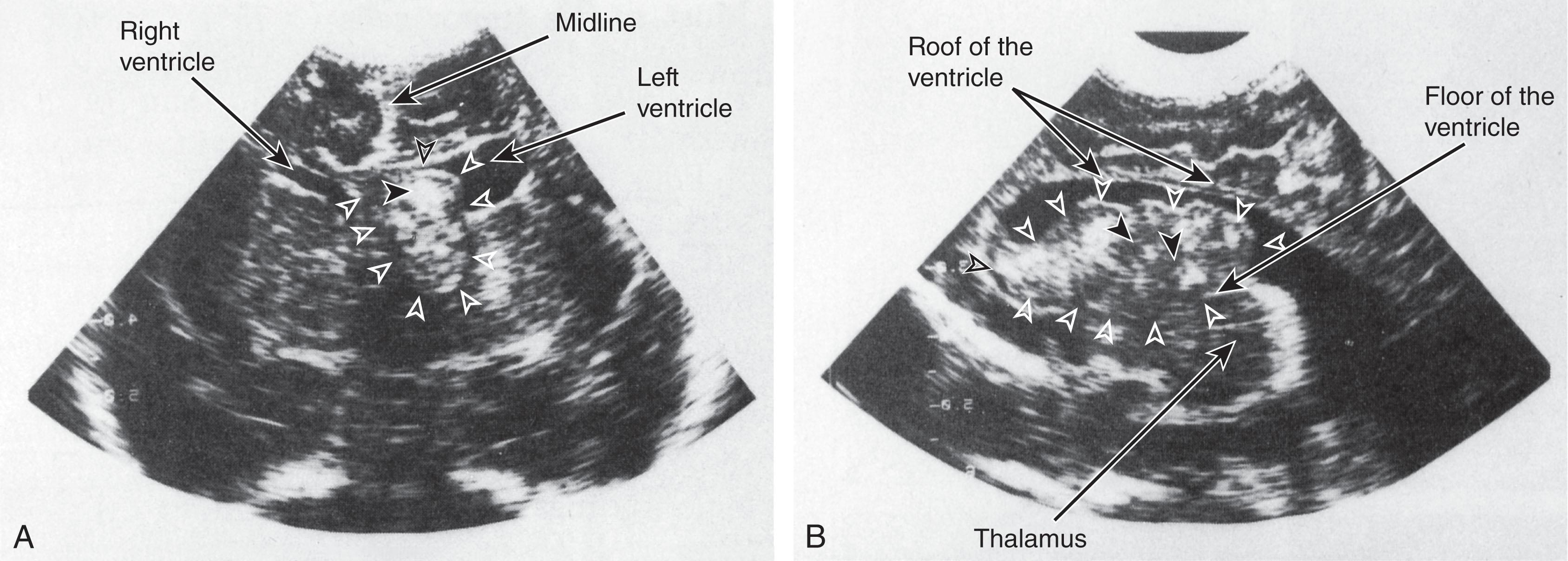
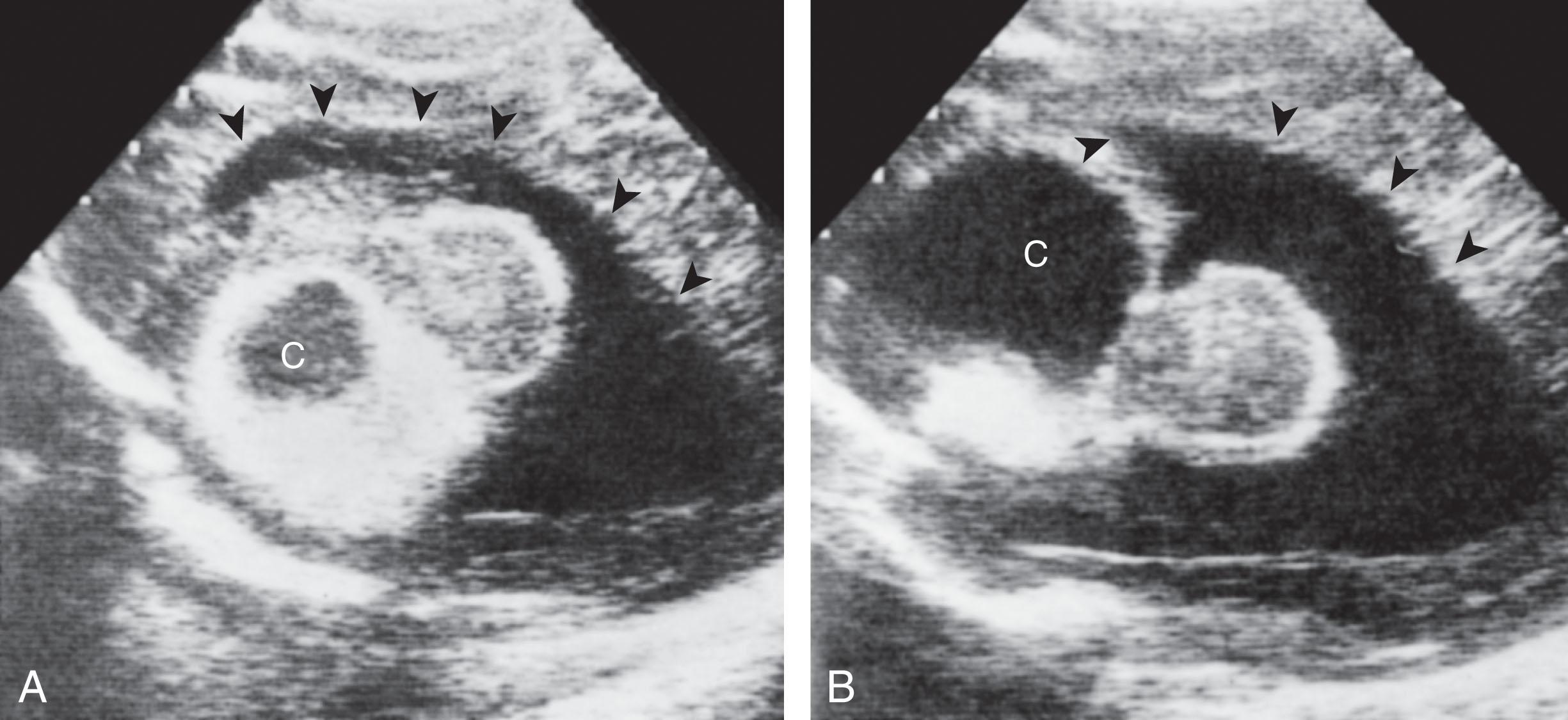
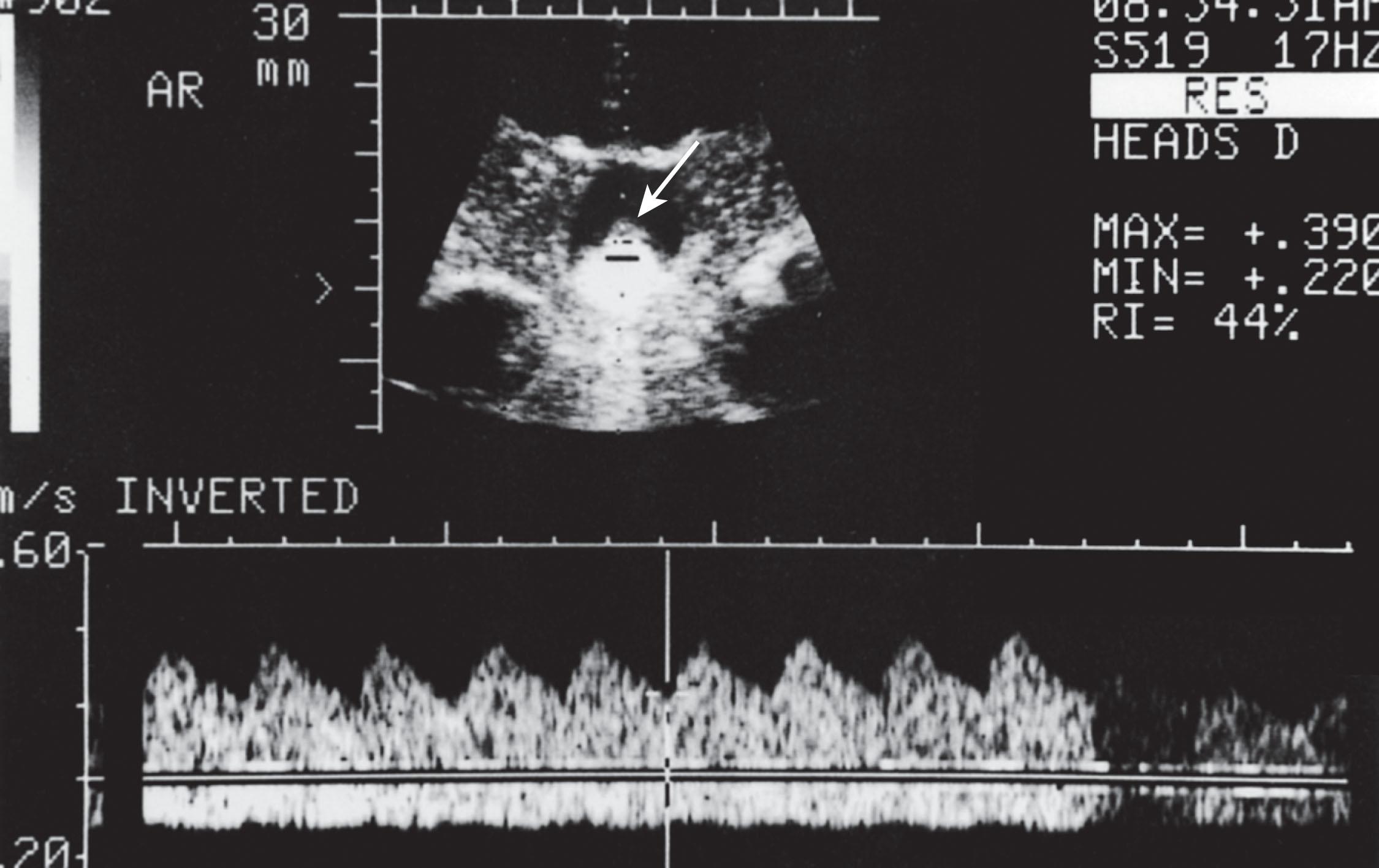
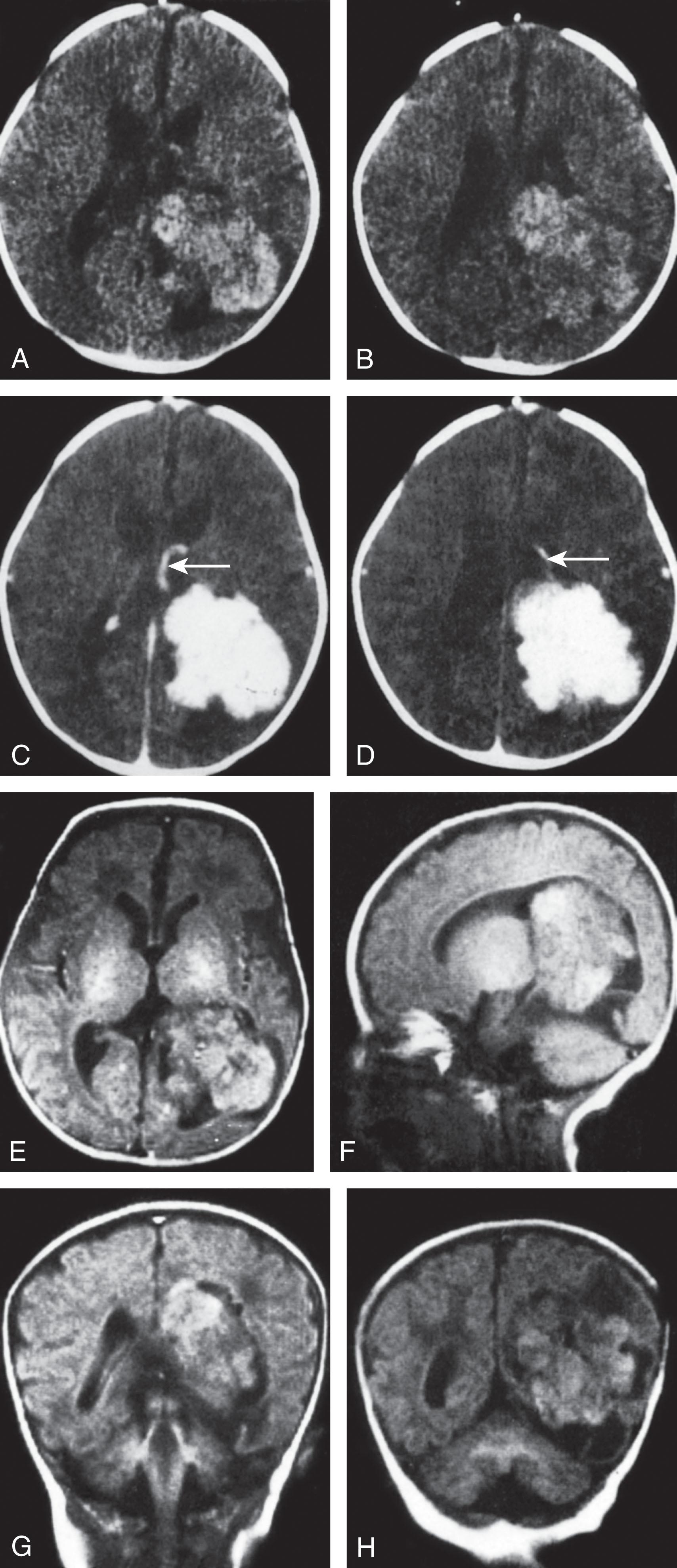


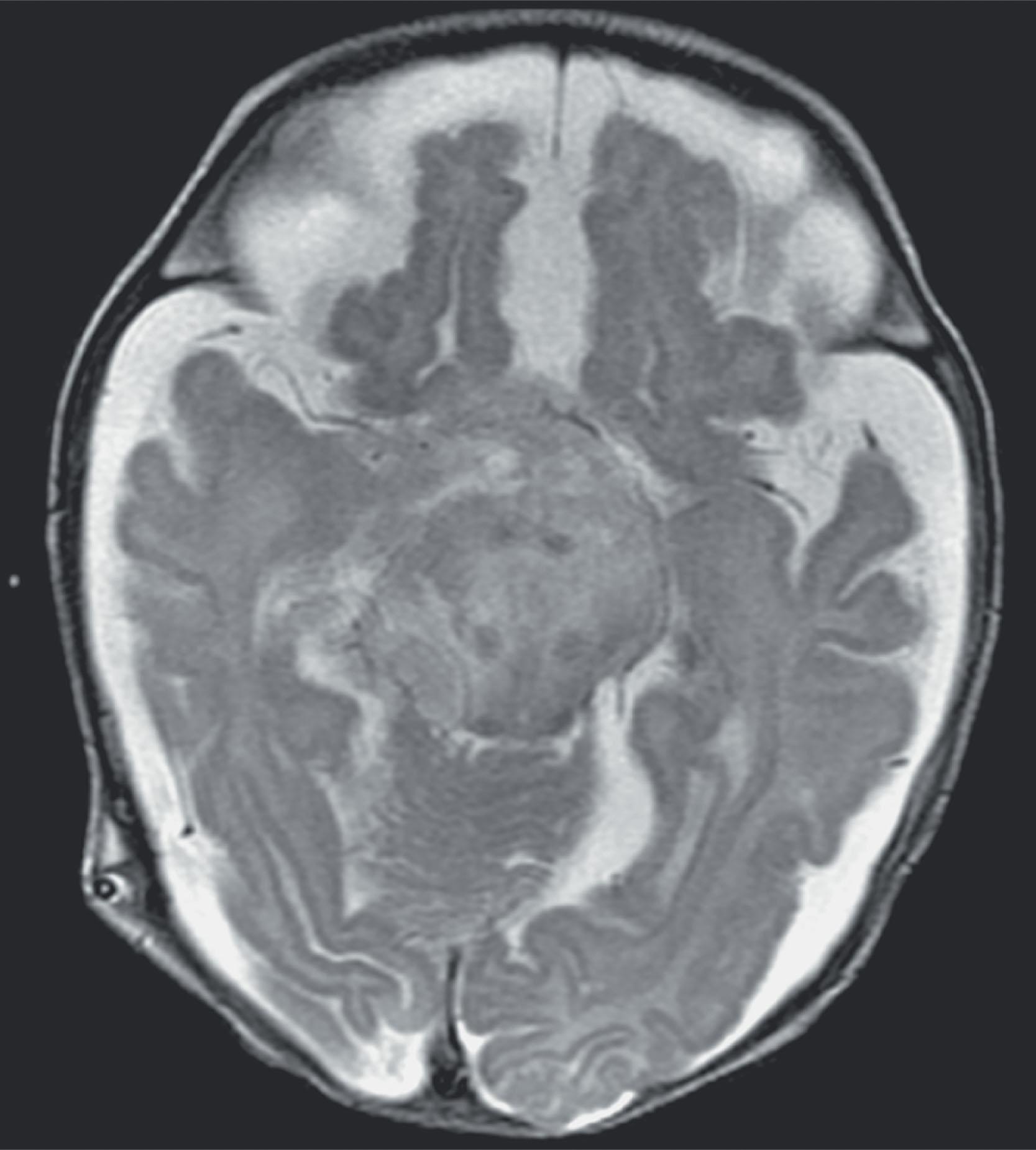
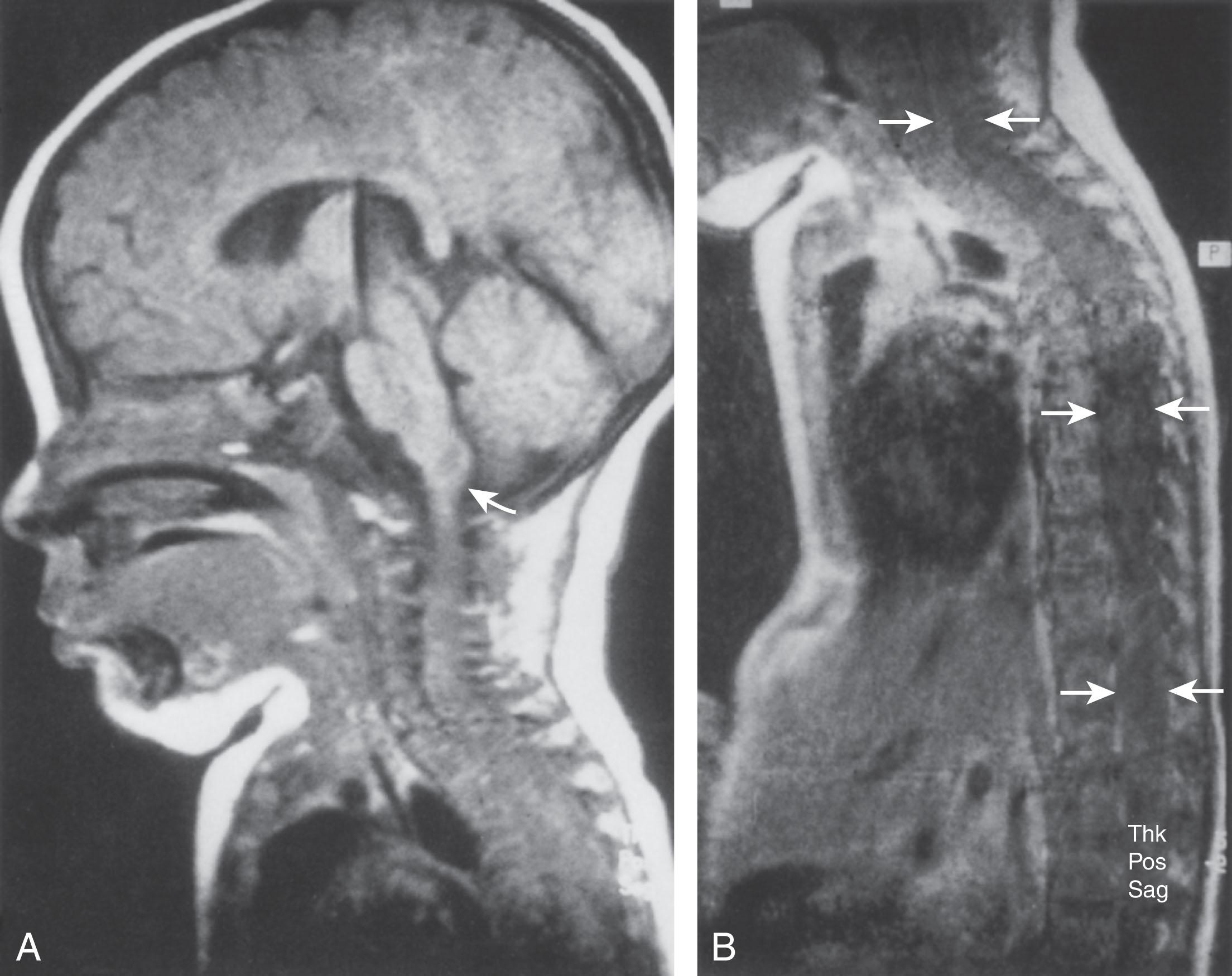
An unusual presentation of brain tumors in infants is the diencephalic syndrome, characterized by failure to thrive, emaciation in the setting of normal caloric intake, hyperkinesia, and nystagmus. This constellation may be seen with tumors of the hypothalamus or thalamus.
The outcome of patients with neonatal brain tumors depends on the size and location of the lesion, the time of diagnosis, and particularly on the histological type of the tumor. General conclusions concerning prognosis of the most common neonatal brain tumors are summarized in Table 41.6 .
|
|
|
|
|
|
|
|
|
|
|
Teratomas are associated with a poor outcome. Mortality rates in these patients generally exceed 90%, principally because the lesions are usually very extensive at the time of identification. In the largest reported experience ( n = 73), the 1-year survival rate for patients with teratomas was 7.2%. Long-term survivors of large embryonal tumors have significant deficits, with 54% exhibiting an intelligence quotient (IQ) less than 70, 85% showing motor deficits, 50% having vision, hearing and/or speech delay, and 25% demonstrating feeding and endocrine abnormalities.
Medulloblastoma manifesting at birth or in the first two postnatal months is also associated with a poor outcome, with mortality rates exceeding 80%. In a series of 19 cases of perinatal medulloblastoma, only 1 survivor was reported. (Some of these tumors would likely now be diagnosed as AT/RTs.)
Choroid plexus papilloma has the most favorable outcome. With rare exceptions, all infants are cured and have a normal outcome. Choroid plexus carcinoma, which accounts for approximately 5% to 10% of neonatal choroid plexus tumors, had been associated with a poor chance for survival until recently, when improvements in chemotherapy appreciably increased the chance of prolonged survival. DIG is often curable with resection. Improvements in microsurgical technique and the use of neoadjuvant chemotherapy have reduced the risk of intraoperative bleeding, which can be substantial.
Astrocytomas and ependymomas are associated with variable outcomes, depending primarily on the degree of differentiation of the tumor and its location. Markedly anaplastic lesions and deep diencephalic and brainstem locations are rarely curable.
Become a Clinical Tree membership for Full access and enjoy Unlimited articles
If you are a member. Log in here